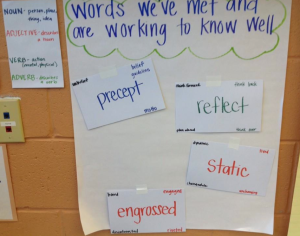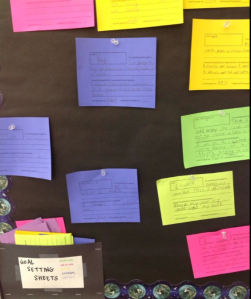just as important to us as the academic subjects we teach is the climate in our classroom. it’s important to us that the kids in our room see the value in working hard over getting it right, and that they treat others with kindness. after reading carol dweck and peter johnston, we’ve made a conscious effort to model, teach and encourage, and celebrate grit.
if you’ve read either dweck or johnston’s work, you know that having grit is hugely important. while some kids seem to be naturally “grittier” than others, we think it is a mindset that can be learned and taught. here are a few ways we’ve tried to do this in our room.
to model grit, we:
- make mistakes in front of kids. usually these are planned mistakes, but either way, whenever we’re met with a mistake as a teacher, we acknowledge it and show that we have the chance to fix it and learn from it, and then keep going.
- avoid using words like: smart, talented, easy. instead, use: tried hard, worked hard, challenging, grew.
- constantly remind students that they’re growing because of their hard work. say things like, “at the beginning of the year, you…but now…” or “remember when…was new, but now…” and, whenever possible, name the steps (or some of the steps!) that students had to work through to get where they are now.
to teach and encourage grit, we:
- actually teach it as one of our vocabulary words. we use word cards (a la shana frazin; see a chart with some examples of vocabulary word cards in our room below) to introduce the definition, synonyms, and antonyms. we decide on an action to help us remember the meaning (for grit, something like punching our open palm with our other fist was suggested by a student). then, we use the word every chance we have so that students begin to use it, too.

- work it into our mini-lessons. when teaching an editing mini-lesson, for example, our teaching point might focus on the mindset a person with grit has and how that affects one’s work rather than the conventions themselves. we might say, “you have a choice to make as a writer, as a person. you can be the type of writer who digs in, who shows grit, and does drastic editing today or you can choose to do cursory editing. which type of editing do you think will affect your piece the most? which type of editing will grow you most as a writer?” (drastic and cursory are also great vocabulary words to teach explicitly.)
- teach kids the importance of the word “yet.” peter johnston taught us about the power of this little word. when you overhear a kid say, “i’m not good at…” say it back to them, adding on the word “yet,” as in, “you mean, you’re not good at…yet?” it’s amazing how this catches on, and it will help gradually shift their mindset, encourage them to keep at it. it sends the message that it’s ok not to be good at something, and that being gritty will change that.
- create opportunities for students to share and discuss what is hard or challenging for them and make sure they’re encountering challenges regularly. teach that there are things they can do to get themselves through hard work. we’ve taught a math lesson that uses the broken escalator video (fourth graders get it – they might be the youngest who do? younger grade teachers, let us know what you think!) and multi-step word problems. we teach students to be metacognitive (another vocabulary word) and they help co-author a chart that we return to throughout the year with ways they can get themselves unstuck by digging deeper into challenging work.
to celebrate grit, we:
- create opportunities for students to share struggles and how they overcame them (or how they’re trying to overcome them if they haven’t yet). this may happen at the end of independent work time, as a share with a partner, or during a morning meeting type of whole-class meeting. once students know the word “grit,” you can even ask: how did you show grit today? when did you have to be gritty?
- have students regularly set and reflect on goals. every friday for our morning meeting, we have students reflect on their goals, share with the class when they reach a goal (we give snaps), and set a new goal. when they set a new goal, they say why it is a goal for them. our goals are posted in a kid-accessible and visible place in our room so that they are able to do this work independently. we also have a place for each student to file their goals that have been met.

while we know that this may seem fluffy to some, and that there’s been a lot of buzz around grit recently, we’re believers in the power of it. the success of our students is largely dependent upon how they see themselves in relation to their work, and having a sense of themselves as people who show grit is an important first step.
I’m so glad to see that you have articulated this critical part of your teaching here for others to try. You have made it seem possible – and I know it is from watching you do it. I also know it is hard to change the way you talk to kids and also to plan for these “tucked in” yet crucial teaching attitudes. Not fluff at all!
LikeLiked by 1 person